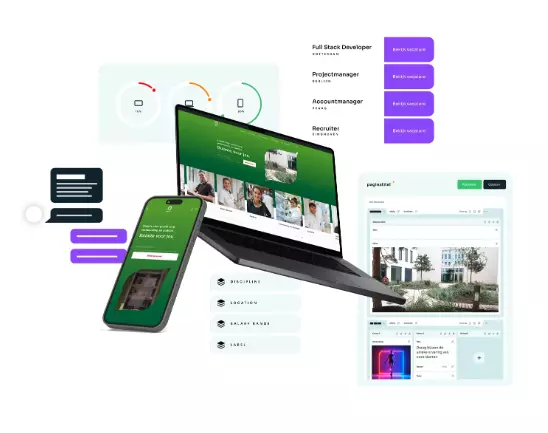This website uses cookies
We, and third parties, use cookies on our website. We use cookies to ensure that our website functions properly, to store your preferences, to gain insight into visitor behavior, but also for marketing and social media purposes (showing personalized advertisements). By clicking 'Accept', you agree to the use of all cookies. In our Cookie Statement. you can read more about the cookies we use and save or change your preferences. By clicking 'Refuse' you only agree to the use of functional cookies.
How to improve your job postings with advanced SEO
September 23, 2025
Reading level: SEO advanced
In today’s tight labor market, online visibility is crucial. Yet many job postings disappear into the depths of Google, Google for Jobs, and job boards like Indeed—mostly because they’re not optimized for search engines.
For those who already master the SEO basics—such as clear job titles, relevant keywords, and keyword integration—the next step is advanced SEO. Read this article to learn how to make your job postings truly discoverable.
For those who already master the SEO basics—such as clear job titles, relevant keywords, and keyword integration—the next step is advanced SEO. Read this article to learn how to make your job postings truly discoverable.

1_>
Optimize for Google for Jobs
Google for Jobs pulls vacancies directly from your website if they meet the correct structured data markup (schema.org). With schema.org, you can add extra context to your content through special tags, helping search engines better understand the meaning behind the content—not just the words.
Key actions include:
Tip: Ask us about the exact fields that are most important when optimizing vacancies for Google for Jobs.
- Use the JobPosting schema and fill in all fields: job title, location, salary range, employment type, publication date, and application deadline.
- Don’t forget validThrough: without an expiration date, Google may rank your posting lower.
- Test your implementation with Google’s Rich Results Test.
Tip: Ask us about the exact fields that are most important when optimizing vacancies for Google for Jobs.
2_>
Make job titles search-friendly
Many organizations write internally focused titles (e.g., Customer Happiness Officer), while candidates search for familiar terms (e.g., Customer Service Representative).
- Combine creativity with search volume: Customer Service Representative (Customer Happiness Officer).
- Use search data from Google Keyword Planner or Google Trends to see what candidates actually search for.
- Create category pages (e.g., marketing jobs, IT jobs) as SEO landing pages and link internally to individual vacancies.
- Ensure unique job descriptions—don’t copy and paste from existing postings.
3_>
Optimize job descriptions for search Intent
Advanced SEO is not just about keywords, but also about search intent. Candidate intent typically falls into three categories:
- Exploratory: “working at [company]”
- Specific: “[job title] in [location]”
- Action-oriented: “apply [job title]”
4_>
Technical SEO for speed and Indexation
Career websites often have dynamic job feeds that load slowly or are difficult to index. To strengthen your Google ranking, address these technical areas:
Regularly monitor both speed and indexation of your pages.
- Enable caching and lazy loading for images (preferably in WebP or AVIF format) to improve load speed.
- Use XML sitemaps specifically for job postings and update them daily.
- Check in Google Search Console whether your vacancies are being indexed—this is a common issue with ATS integrations.
Regularly monitor both speed and indexation of your pages.
5_> Content enrichment for higher engagement
Content enrichment means adding extra value to your job descriptions and landing pages so candidates feel more informed and engaged. Instead of listing only requirements, enriched content provides context, storytelling, and interaction. This boosts engagement and increases the likelihood of applications. Google also rewards rich content.
Ideas include:
- Add videos of employees explaining the role.
- Use FAQ sections with structured data to increase chances of appearing as rich snippets.
- Include workplace photos, optimized with SEO alt text that references the job role.
6_> Consistent publishing and re-optimization
Job postings age quickly online. Publish new vacancies consistently and promote them via social media, paid advertising, and newsletters. For jobs that remain open longer, update them regularly—refresh the publication date, adjust keywords, and add new content.
By consistently applying this approach, you not only increase visibility but also improve candidate quality—and ultimately, that’s the most important recruitment KPI.
By consistently applying this approach, you not only increase visibility but also improve candidate quality—and ultimately, that’s the most important recruitment KPI.
Want to know how your current recruitment website scores on these points?
Get in touch—we’d be happy to run a quick scan or give you a demo of our Hamilton CMS!
Proud of our customers
From leading corporations to fast-growing organizations, we've helped many great employers increase their visibility and attract talent. We pride ourselves on long-term partnerships where we continuously optimize and innovate.

We create brand-customized recruitment sites with our own developed Hamilton CMS 👋🏼.
Interested?








